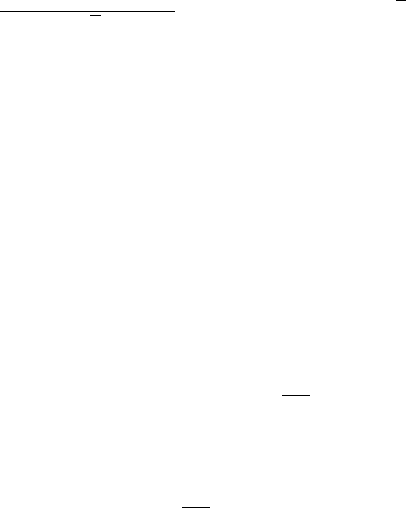Jeanblanc M., Yor M., Chesney M. Mathematical Methods for Financial Markets
Подождите немного. Документ загружается.


6.6 Asian Options 387
where J
x
(here, x =4) was computed in Proposition 6.2.5.3 as the Laplace
transform of the pair (ρ
t
,
t
0
ρ
s
ds) for a squared Bessel process with index ν,
starting from x as
J
a,b,ν
x
(t)=
cosh(bt)+2ab
−1
sinh(bt)
−ν−1
exp
−
1
2
xb
1+2ab
−1
coth(bt)
coth(bt)+2ab
−1
.
Proof: We start with the formula established in Lemma 6.6.2.1:
∞
0
k(t)e
−θ
2
t/2
dt = P
(θ)
∞
0
du f (u)
h(R
u
)g(K
u
)
R
2+θ
u
.
If R is a Bessel process with index θ, then, from Exercice 6.2.4.3 with q =2,
R
t
=
1
4
R
2
(
t
0
ds
R
s
), where
R is a BES with index 2θ. Using the notation of
Lemma 6.6.2.1 and introducing the inverse H of the increasing process K as
H
t
=inf{u : K
u
= t},
K
H
t
= t =
H
t
0
ds
R
s
.
By differentiation, we obtain dH
t
= R
H
t
dt and H
t
=
1
4
t
0
R
2
s
ds. It follows
that
∞
0
k(t)e
−θ
2
t/2
dt =4
1+θ
∞
0
dt g(t) P
(2θ)
h(4
−1
R
2
t
)f(4
−1
t
0
R
2
s
ds)
R
2(1+θ)
t
.
In particular, for f(x)=e
−4bx
,g(x)=e
−cx
and h(x)=e
−4ax
, we obtain
E(exp(−aW
Θ
− bA
Θ
− cA
†
Θ
))
=4
1+θ
∞
0
dt e
−ct
P
2θ
exp(−a
R
2
t
− b
t
0
R
2
s
ds)
R
2(1+θ)
t
.
Using the identity r
−γ
=
1
Γ (γ)
∞
0
dy e
−ry
y
γ−1
we transform the quantity
1
b
R
2(1+θ)
t
. The initial condition R
0
= 1 implies
R
0
= 2 and, denoting ρ
t
=
R
2
t
,
P
(2θ)
exp(−a
R
2
t
− b
t
0
R
2
s
ds)
R
2(1+θ)
t
=
1
Γ (1 + θ)
Q
(2θ)
4
dy y
θ
exp(−(a + y)ρ
t
− b
t
0
ρ
s
ds)
.
From 6.2.14 we know the Laplace transform of the pair (ρ
t
,
t
0
ρ
s
ds), where ρ
isaBESQofindex2θ, starting from ρ
0
=4.
Exercise 6.6.2.8 Check that the distribution of A
(ν)
Θ
is that of B/(2Γ )where
B has a Beta(1,α)lawandΓ a Gamma(β,1) law with
α =
ν + γ
2
,β=
γ − ν
2
,γ=
2λ + ν
2
.
See Dufresne [282].

388 6 A Special Family of Diffusions: Bessel Processes
6.6.3 The Moments of A
t
The moments of A
(ν)
t
exist because
te
−2tν
−
+2m
t
≤ A
(ν)
t
≤ te
2tν
+
+2M
t
where m
t
=inf
s≤t
W
s
,M
t
=sup
s≤t
W
s
.
Elementary arguments allow us to compute the moments of A
t
= A
(0)
t
.
Proposition 6.6.3.1 The moments of the random variable A
t
are given by
E(A
n
t
)=
1
4
n
E(P
n
(e
2W
t
)),whereP
n
is the polynomial
P
n
(z)=2
n
(−1)
n
⎛
⎝
1
n!
+2
n
j=1
n!(−z)
j
(n − j)! (n + j)!
⎞
⎠
.
Proof: Let μ ≥ 0andλ>ϕ(μ + n), where ϕ(x)=
1
2
x
2
. Then,
Φ
n
(t, μ):=E
t
0
ds e
W
s
n
e
μW
t
= n!
t
0
ds
1
s
1
0
ds
2
···
s
n−1
0
ds
n
E[exp(W
s
1
+ ···+ W
s
n
+ μW
t
)] .
The expectation under the integral sign is easily computed, using the
independent increments property of the BM as well as the Laplace transform
E[exp(W
s
1
+ ···+ W
s
n
+ μW
t
)] =
exp [ϕ(μ)(t − s
1
)+ϕ(μ +1)(s
1
− s
2
)+···+ ϕ(μ + n)s
n
)] .
It follows, by integrating successively the exponential functions that
∞
0
dte
−λt
E
t
0
ds e
W
s
n
e
μW
t
=
n!
n
(
j=0
(λ − ϕ(μ + j))
.
Setting, for fixed j, c
(μ)
j
=
(
0≤k=j≤n
ϕ(μ + j) − ϕ(μ + k)
−1
, the use of the
formula
1
)
n
j=0
(λ − ϕ(μ + j))
=
n
j=0
c
j
(μ)
1
λ − ϕ(μ + j)
and the invertibility of the Laplace transform lead to
E
t
0
ds e
W
s
n
e
μW
t
= E(e
μW
t
P
(μ)
n
(e
W
t
))

6.6 Asian Options 389
where P
(μ)
n
is the sequence of polynomials
P
(μ)
n
(z)=n!
n
j=0
c
(μ)
j
z
j
.
In particular, we obtain
E
t
0
dse
W
s
n
= E(P
(0)
n
(e
W
t
))
and, from the scaling property of the BM,
α
2n
E
t
0
dse
αW
s
n
= E(P
(0)
n
(e
αW
t
)) .
Therefore, we have obtained the moments of A
(0)
t
. The general case follows
using Girsanov’s theorem.
E([A
(ν)
t
]
n
)=
n!
2
2n
⎛
⎝
n
j=0
c
(ν/2)
j
exp
(2j
2
+2jν)t
⎞
⎠
.
Nevertheless, knowledge of the moments is not enough to characterize the
law of A
t
. Recall the following result:
Proposition 6.6.3.2 (Carleman’s Criterion.) If a random variable X
satisfies
(m
2n
)
−1/2n
= ∞ where m
2n
= E(X
2n
), then its distribution is
determined by its moments.
However, this criterion does not apply to the moments of A
(ν)
t
(see Geman
and Yor [383]). The moments of A
t
do not characterize its law (see H¨orfelt
[446] and Nikeghbali [673]). On the other hand, Dufresne [279]provedthat
the law of 1/A
(ν)
t
is determined by its moments. We recall that the log-normal
law is not determined by its moments.
Comment 6.6.3.3 A computation of positive and negative moments can
be found in Donati-Martin et al. [259]. See also Dufresne [279, 282],
Ramakrishnan [728] and Schr¨oder [771].
6.6.4 Laplace Transform Approach
We now return to the computation of the price of an Asian option, i.e., to the
computation of
Ψ(T,K)=E
⎡
⎣
T
0
exp[2(W
s
+ μs)] ds − K
+
⎤
⎦
. (6.6.7)

390 6 A Special Family of Diffusions: Bessel Processes
Indeed, as seen in the beginning of Section 6.6, one can restrict attention to
the case σ =2since
C
Asian
(S
0
,K)=e
−rT
S
0
T
E
⎡
⎣
T
0
e
σ(W
s
+νs)
ds −
KT
S
0
+
⎤
⎦
= e
−rT
4S
0
σ
2
T
Ψ
σ
2
T
4
,
KTσ
2
4S
0
.
The Geman and Yor method consists in computing the Laplace transform
(with respect to the maturity) of Ψ, i.e.,
Φ(λ)=
∞
0
dt e
−λt
Ψ(t, K)=E
∞
0
dt e
−λt
t
0
e
2(W
s
+μs)
ds − K
+
= E
∞
0
dt e
−λt
(A
(μ)
t
− K)
+
.
Lamperti’s result (Theorem 6.2.4.1) and the change of time A
(μ)
t
= u yield
to
Φ(λ)=P
(μ)
1
∞
0
du e
−λC
u
1
(R
u
)
2
(u − K)
+
where C is the inverse of A. From the absolute continuity of Bessel laws (6.1.5)
P
(μ)
1
|
F
t
=
R
t
μ−γ
exp
−
μ
2
− γ
2
2
C
t
P
(γ)
1
|
F
t
with γ given by λ =
1
2
(γ
2
− μ
2
)and
Φ(λ)=P
(γ)
1
∞
0
du
1
R
2+γ−μ
u
(u − K)
+
.
The transition density of a Bessel process, given in (6.2.3), now leads to
Φ(λ)=
∞
K
du
u − K
u
∞
0
dρ
ρ
1−μ
exp
−
1+ρ
2
2u
I
μ
(
ρ
u
) .
It remains to invert the Laplace transform.
Comment 6.6.4.1 Among the papers devoted to the study of the law of
the integral of a geometric BM and Asian options we refer to Buecker and
Kelly-Lyth [135], Carr and Schr¨oder [156], Donati-Martin et al. [258], Dufresne
[279, 280, 282], Geman and Yor [382, 383], Linetsky [594], Lyasoff [606], Yor
[863], Schr¨oder [767, 769], and Ve˘ce˘randXu[827]. Nielsen and Sandmann
[672] study the pricing of Asian options under stochastic interest rates. In
this book, we shall not consider Asian options on interest rates. A reference
is Poncet and Quittard-Pinon [722].

6.6 Asian Options 391
Exercise 6.6.4.2 Compute the price of an Asian option in a Bachelier
framework, i.e., compute
E
⎛
⎝
T
0
(νs + σW
s
)ds − K
+
⎞
⎠
.
Exercise 6.6.4.3 Prove that, for fixed t,
A
(ν)
t
law
=
t
0
e
2(ν(t−s)+W
t
−W
s
ds :=Y
(ν)
t
and that, as a process
dY
(ν)
t
=(2(ν +1)Y
(ν)
t
+1)dt +2Y
(ν)
t
dW
t
.
See Carmona et al. [141], Donati-Martin et al. [258], Dufresne [277]and
Proposition 11.2.1.7.
6.6.5 PDE Approach
A second approach to the evaluation problem, studied in Stanton [805], Rogers
and Shi [740] and Alziary et al. [11] among others, is based on PDE methods
and the important fact that the pair (S
t
,Y
t
) is Markovian where
Y
t
:=
1
S
t
1
T
t
0
S
u
du − K
.
The value C
Asian
t
of an Asian option is a function of the three variables: t,
S
t
and Y
t
, i.e., C
Asian
t
= S
t
A(t, Y
t
) and, from the martingale property of
e
−rt
C
Asian
t
, we obtain that A is the solution of
∂A
∂t
+
1
T
− ry
∂A
∂y
+
1
2
σ
2
y
2
∂
2
A
∂y
2
= 0 (6.6.8)
with the boundary condition A(T,y)=y
+
.
Furthermore, the hedging portfolio is A(t, Y
t
) − Y
t
A
y
(t, Y
t
). Indeed
d(e
−rt
C
Asian
t
)=σS
t
e
−rt
A(t, Y
t
) − Y
t
A
y
(t, Y
t
)
dW
t
=
A(t, Y
t
) − Y
t
A
y
(t, Y
t
)
d
˜
S
t
.

392 6 A Special Family of Diffusions: Bessel Processes
6.7 Stochastic Volatility
6.7.1 Black and Scholes Implied Volatility
In a Black and Scholes model, the prices of call options with different strikes
and different maturities are computed with the same value of the volatility.
However, given the observed prices of European calls C
obs
(S
0
,K,T)onan
underlying with value S
0
, with maturity T and strike K, the Black and
Scholes implied volatility is defined as the value σ
imp
of the volatility
which, substituted in the Black and Scholes formula, gives equality between
the Black and Scholes price and the observed price, i.e.,
BS (S
0
,σ
imp
,K,T)=C
obs
(S
0
,K,T) .
Now, this parameter σ
imp
depends on S
0
,T and K as we just wrote. If the
Black and Scholes assumption were satisfied, this parameter would be constant
for all maturities and all strikes, and, for fixed S
0
, the volatility surface
σ
imp
(T,K) would be flat. This is not what is observed. For currency options,
the profile is often symmetric in moneyness m = K/S
0
. This is the well-known
smile effect (see Hagan et al. [417]). We refer to the work of Cr´epey [207]for
more information on smiles and implied volatilities. A way to produce smiles
is to introduce stochastic volatility. Stochastic volatility models are studied in
details in the books of Lewis [587], Fouque et al. [356].
Here, we present some attempts to solve the problem of option pricing for
models with stochastic volatility.
6.7.2 A General Stochastic Volatility Model
This section is devoted to some examples of models with stochastic volatility.
Let us mention that a model
dS
t
= S
t
(μ
t
dt + σ
t
d
W
t
)
where
1
W is a BM and μ, σ are F
f
W
-adapted processes is not called a stochastic
volatility model, this name being generally reserved for the case where the
volatility induces a new source of noise. The main models of stochastic
volatility are of the form
dS
t
= S
t
(μ
t
dt + σ(t, Y
t
)d
W
t
)
where μ is F
f
W
-adapted and
dY
t
= a(t, Y
t
)dt + b(t, Y
t
)d
B
t
1
Throughout our discussion, we shall use tildes and hats for intermediary BMs,
whereas W and W
(1)
will denote our final pair of independent BMs.

6.7 Stochastic Volatility 393
(or, equivalently,
df (Y
t
)=α(t, Y
t
)dt + β(t, Y
t
)d
B
t
for a smooth function f)where
B is a Brownian motion, correlated with
W
(with correlation ρ). The independent case (ρ = 0) is an interesting model,
but more realistic ones involve a correlation ρ = 0.Some authors add a jump
component to the dynamics of Y (see e.g., the model of Barndorff-Nielsen and
Shephard [55]).
In the Hull and White model [453], σ(t, y)=y and Y follows a geometric
Brownian motion. We shall study this model in the next section. In the Scott
model [775],
dS
t
= S
t
(μ
t
dt + Y
t
d
W
t
)
where Z =ln(Y ) follows a Vasicek process:
dZ
t
= β(a − Z
t
)dt + λd
B
t
where a, β and λ are constant. Heston [433] relies on a square root process
for the square of the volatility.
Obviously, if the volatility is not a traded asset, the model is incomplete,
and there exist infinitely many e.m.m’s, which may be derived as follows. In a
first step, one introduces a BM
W , independent of
W such that
B
t
= ρ
W
t
+
1 − ρ
2
W
t
. Then, any σ(
B
s
,
W
s
,s ≤ t)=σ(
W
s
,
W
s
,s ≤ t)-martingale can
be written as a stochastic integral with respect to the pair (
W,
W ). Therefore,
any Radon-Nikod´ym density satisfies
dL
t
= L
t
(φ
t
d
W
t
+ γ
t
d
W
t
) ,
for some pair of predictable processes φ, γ. We then look for conditions on the
pair (φ, γ) such that the discounted price SR is a martingale under Q = LP,
that is if the process LSR is a P-local martingale. This is the case if and only if
−r + μ
t
−σ(t, Y
t
)φ
t
= 0. This involves no restriction on the coefficient γ other
than
t
0
γ
2
s
ds < ∞ and the local martingale property of the process LSR.
6.7.3 Option Pricing in Presence of Non-normality of Returns:
The Martingale Approach
We give here a second motivation for introducing stochastic volatility models.
The property of non-normality of stock or currency returns which has been
observed and studied in many articles is usually taken into account by relying
either on a stochastic volatility or on a mixed jump diffusion process for the
price dynamics (see Chapter 10).
Strong underlying assumptions concerning the information arrival dynam-
ics determine the choice of the model. Indeed, a stochastic volatility model
will be adapted to a continuous information flow and mixed jump-diffusion

394 6 A Special Family of Diffusions: Bessel Processes
processes will correspond to possible discontinuities in this flow of information.
In this context, option valuation is difficult. Not only is standard risk-neutral
valuation usually no longer possible, but these models rest on the valuation of
more parameters. In spite of their complexity, some semi-closed-form solutions
have been obtained.
Let us consider the following dynamics for the underlying (a currency):
dS
t
= S
t
μdt + σ
t
d
B
t
, (6.7.1)
and for its volatility:
dσ
t
= σ
t
f(σ
t
)dt + γd
W
t
. (6.7.2)
Here, (
B
t
,t≥ 0) and (
W
t
,t≥ 0) are two correlated Brownian motions under
the historical probability, and the parameter γ is a constant.
In the Hull and White model [453] the underlying is a stock and the
function f is constant, hence σ follows a geometric Brownian motion. In the
Scott model [775], this function has the form: f(σ)=β(a − ln(σ)) + γ
2
/2,
where the parameters a, β and γ are constant.
The standard Black and Scholes approach of riskless arbitrage is not
enough to produce a unique option pricing function C
E
. Indeed, the volatility
is not a traded asset and there is no asset perfectly correlated with it. The
three assets required in order to eliminate the two sources of uncertainty and
to create a riskless portfolio will be the foreign bond and, for example, two
options of different maturities. Therefore, it will be impossible to determine
the price of an option without knowing the price of another option on the
same underlying (See Scott [775]).
Under any risk-adjusted probability Q, the dynamics of the underlying
spot price and of the volatility are given by
⎧
⎪
⎨
⎪
⎩
dS
t
= S
t
(r − δ)dt + σ
t
d
B
t
,
dσ
t
= σ
t
(f (σ
t
) − Φ
σ
t
)dt + γσ
t
dW
t
(6.7.3)
where (
B
t
,t≥ 0) and (W
t
,t≥ 0) are two correlated Q-Brownian motions and
where Φ
σ
t
, the risk premium associated with the volatility, is unknown since
the volatility is not traded.
The expression of the underlying price at time T
S
T
= S
0
exp
(r − δ)T −
1
2
T
0
σ
2
u
du +
T
0
σ
u
d
B
u
, (6.7.4)
which follows from (6.7.3), will be quite useful in pricing European options as
is now detailed.
We first start with the case of 0 correlation between
B and W .

6.7 Stochastic Volatility 395
Proposition 6.7.3.1 Assume that the dynamics of the underlying spot price
(for instance a currency) and of the volatility are given, under the risk-adjusted
probability, by equations (6.7.3), with a zero correlation coefficient, where
the risk premium Φ
σ
associated with the volatility is assumed constant. The
European call price can be written as follows:
C
E
(S
0
,σ
0
,T)=
+∞
0
BS (S
0
e
−δT
,a,T)dF(a) (6.7.5)
where BS is the Black and Scholes price:
BS (x, a, T )=xN (d
1
(x, a)) − Ke
−rT
N (d
2
(x, a)) .
Here,
d
1
(x, a)=
ln(x/K)+rT + a/2
√
a
,d
2
(x, a)=d
1
(x, a) −
√
a,
δ is the foreign interest rate and F is the distribution function (under the
risk-adjusted probability) of the cumulative squared volatility Σ
T
defined as
Σ
T
=
T
0
σ
2
u
du . (6.7.6)
Proof: The stochastic integral which appears on the right-hand side of (6.7.4)
is a stochastic time-changed Brownian motion:
t
0
σ
u
d
B
u
= B
∗
Σ
t
where (B
∗
s
,s≥ 0) is a Q-Brownian motion. Therefore,
S
T
= S
0
exp
(r − δ)T + B
∗
Σ
T
−
Σ
T
2
and the conditional law of ln(S
T
/S
0
) given Σ
T
is
N
(r − δ)T −
Σ
T
2
,Σ
T
.
By conditioning with respect to Σ
T
, returns are normally distributed, and the
Black and Scholes formula can be used for the computation of the conditional
expectation
C
T
:=E
Q
(e
−rT
(S
T
− K)
+
|Σ
T
) .
Formula (6.7.5) is therefore obtained from
E
Q
(e
−rT
(S
T
− K)
+
)=E
Q
(
C
T
)=E
Q
(BS (S
0
,Σ
T
,K)).

396 6 A Special Family of Diffusions: Bessel Processes
In order to use this result, the risk-adjusted distribution function F of Σ
T
is
needed. One method of approximating the option price is the Monte Carlo
method. By simulating the instantaneous volatility process σ over discrete
intervals from 0 to T , the random variable Σ
T
can be simulated. Each value
of Σ
T
is substituted into the Black and Scholes formula with Σ
T
in place of
σ
2
T . The sample mean converges in probability to the option price as the
number of simulations increases to infinity. The estimates for the parameters
of the volatility process could be computed by methods described in Scott [775]
andinChesneyandScott[177] for currencies: the method of moments and
the use of ARMA processes. The risk premium associated with the volatility,
i.e., Φ
σ
, which is assumed to be a constant, should also be estimated.
6.7.4 Hull and White Model
Hull and White [453] consider a stock option (δ = 0); they assume that the
volatility follows a geometric Brownian motion and that it is uncorrelated
with the stock price and has zero systematic risk. Hence, the drift f (σ
t
)of
the volatility is a constant k and Φ
σ
is taken to be null:
dσ
t
= σ
t
(kdt + γdW
t
) . (6.7.7)
They also introduce the following random variable: V
T
= Σ
T
/T .Inthis
framework, they obtain another version of equation (6.7.5):
C
E
(S
0
,σ
0
,T)=
+∞
0
BS (S
0
,vT,T)dG(v) (6.7.8)
where G is the distribution function of V
T
.
Approximation
By relying on a Taylor expansion, the left-hand side of (6.7.8)maybe
approximated as follows: introduce C(y)=BS(S
0
,yT,T), then
C
E
(S
0
,σ
0
,T) ≈C(∇
T
)+
1
2
d
2
C
dy
2
(∇
T
)Var(V
T
)+···
where
∇
T
:=
E(Σ
T
)
T
= E(V
T
) .
We recall the following results:
⎧
⎪
⎪
⎨
⎪
⎪
⎩
E(V
T
)=
e
κT
− 1
κT
σ
2
0
E(V
2
T
)=
2e
(2κ+ϑ
2
)T
(κ + ϑ
2
)(2κ + ϑ
2
)T
2
+
2
κT
2
1
2κ + ϑ
2
−
e
κT
κ + ϑ
2
σ
4
0
(6.7.9)
